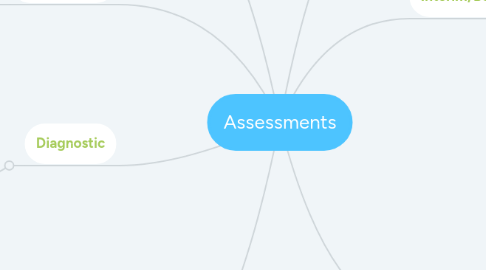
1. Formative
1.1. Formal and informal assessments given to students during learning to gage comprehension and adjust instruction based off of the students' needs.
1.1.1. Exit Tickets (Formal)
1.1.2. Class Discussions (Informal)
2. Interim/Benchmark
2.1. Interim/Benchmark assessments are given to students throughout the school year to evaluate how they are doing thus far and predict how they will preform on future assessments.
2.1.1. District Benchmark
2.1.2. Common Assessment
3. Summative
3.1. The goal of summative assessments is to gage a students learning at the end of a unit.
3.1.1. Standardized Testing
3.1.2. End of Unit Exam
4. Performance
4.1. Performance assessments evaluate a students learning by requiring them to complete a task, verses taking a "traditional" test.
4.1.1. Group Projects (posters, presentations, etc.)
4.1.2. Portfolios
5. Diagnostic
5.1. A form of testing that assists the teacher in discovering their students' strengths, weaknesses, learning styles, and previous knowledge before beginning instruction.
5.1.1. Quickwrites
5.1.2. Rigby Reading Levels (students tested at the beginning of the year)
6. H.O.T. Questions
6.1. Opening Questions
6.1.1. The title of our story is Leo: A Ghost Story. Before we begin reading, what comes to you mind when you hear the word "ghost"?
6.1.2. What kind of story do you predict this story to be?
6.2. Guided Questions
6.2.1. How do you think Leo felt when the family was talking about him? Use evidence from the story to support your answer.
6.2.2. From what we have read so far, what can you tell me about Jane? What kind of girl is she? What from the book supports your answer?
6.3. Closing Questions
6.3.1. What was your favorite part of the story? Why?
6.3.2. What was the happened in the beginning, middle and end of the story? Give me a summary.
7. Current Data
7.1. Three of the struggling students for RTI scored below the passing score on a recent benchmark. These three students' scores were 54%, 50% and 36%.
7.1.1. Student 1 Score: 54%
7.1.1.1. Reteach concepts based on the TEKS the student struggled with the most.
7.1.1.2. Use the data to determine who the student should be in a small group with.
7.1.2. Student 2 Score: 50%
7.1.2.1. Provide after school tutoring.
7.1.2.2. Differentiate homework to address the concepts needing the most review for this student.
7.1.3. Student 3 Score: 36%
7.1.3.1. Determine what concepts need to be reviewed during centers.
7.1.3.2. Review testing strategies to best assist the student when taking future benchmark/standardized tests.

